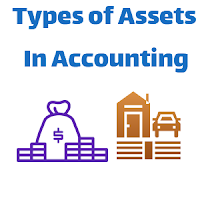Types of Assets In Accounting
 Assets are the resources of the business owned by the business against which the business will expect probable future economic benefits. These are contributed
to the business against the claims of Outsiders (External Liabilities) or Internal Owners (Internal Liabilities or Equity or Capital) of the business according to Accounting Equation i.e., Assets = Liabilities + Owners’Equity.
Assets are the resources of the business owned by the business against which the business will expect probable future economic benefits. These are contributed
to the business against the claims of Outsiders (External Liabilities) or Internal Owners (Internal Liabilities or Equity or Capital) of the business according to Accounting Equation i.e., Assets = Liabilities + Owners’Equity.
Assets can be divided based on: Time Period, Physical Existence, Future Aspects, Financial Aspects, Investment Aspects, Liquidating Aspects, etc.
1. Current And Fixed Assets
The two Primary types of Assets are Current Assets and Non Current Assets / Fixed Assets Long-term Assets.. Current Assets having life equal to one year or less while Non Current Assets have long life usually more than one year.
List of Current Assets are
List of Non Current Assets / Fixed Assets include the following:
(i) Land
(ii) Buildings
(iii) Plant & Machinery
(iv) Furniture & Fixtures
(iv) Office Equipment
2. Tangible And Intangible Assets
Those assets which we can see and touch are Tangible Assets. It include both Tangible Current And Tangible Fixed Assets / Tangible Non Current Assets. Examples are Cash, Inventory, Land, Buildings, Machinery, etc
Other Assets which we can’t see and touch are Intangible Assets. List of these Assets are Accounts Receivable, Prepaid Expenses, Investments, Goodwill, Patents, Franchise, Copyrights, Trademark, etc.
3. Contingent Assets
From the point view of future aspects, assets are classified as Contingent Assets which it is estimated based on the happening of future event that will probably provide future economic
benefits to the business in the form of gain. However, an entity can only recognize and record future gain as an Contingent Asset when it is realized and becomes certain that it provides benefit to the entity’s business.
The entity is required to disclose such Contingent Assets to the Notes to the Accounts when it is probable estimated. For Example, if the settlement between companies is 99% sure that it will give Benefit of Rs. 1000000
as Goodwill to the Acquier, these Contingent Asset is shown on notes to the accounts but if the settlement between two companies will be officially announced then it is certain that the goodwill of the acquiree company will
now becomes the Fixed Asset Or Non Currents Asset of the acquirer and it should be recorded on the Balance Sheet of acquirer’business.
4. Financial & Investing Assets
These are used for investment purpose to finance of the business like Investment in Shares, Profit And Loss Account Opened in a Bank, etc.
6. Liquidating Assets
Assets which have Liquidity in Nature or very quickly convertible into cash are Liquidating Assets. List of such Assets are Cash and Cash Equivalents
like Share, Marketable Securities like Commercial Paper, etc,
7. Depreciating Assets
These Assets are Depreciable Assets as these have limited Useful Life, usually 1 to 2 Years. The Best Examples are Motor Vehicle, Machinery, Office Equipment, etc.
Comments